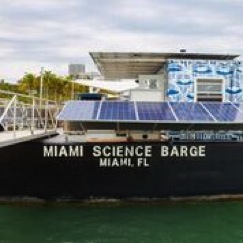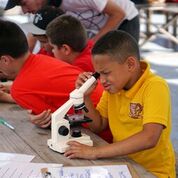Posted December 12, 2016
By COURTNEY CHENNAULT
To the north of the massive American Airlines Arena, concealed by the beautiful trees staggered on Miami’s Museum Park, and all the way down the elongated sidewalk adjacent to the water floats a small yet spectacular environmental science and sustainability lab.

The entrance to the Miami Science Barge in downtown Miami (Photo courtesy of the Miami Science Barge).
This lab, named The Miami Science Barge, is a true community gem with unique components that excite and educate. All components promote the message of sustainable treatment of our environment.
What exactly is environmental sustainability? Gina Maranto, director of the Ecosystem Science and Policy Department at the University of Miami, defines sustainability as treating the environment in a way that allows future generations to survive.
“This means not exhausting resources,” Maranto stated.
One of the barge’s sustainability components is the hydroponics system, a system in which crops and plants grow in highly nutrient water rather than in soil.
This system incorporates connected tubes through which the water flows and recirculates to reach the plants.
According to Michael Coogan, educator and living systems technician at the barge, this system uses 20 times less water than traditional growing methods because no water is lost through evaporation or runoff.
In addition to conserving water, the hydroponics system has an interesting impact on the crops themselves.
“The plants grow twice as fast,” declared Coogan. “In the system we’re growing lettuce, basil, oregano, beans, and others.”
“The plants grow faster because nutrients get directly to the roots all the time,” Maranto explained.
On the other side of the barge rests the vertical integrated greenhouse, or VIG. This construct is a hydroponics system that was patented by the barge’s designer. The VIG grows plants vertically, allowing many to grow in a confined space.
The barge also showcases a fish hatchery display full of seahorses, shrimp, and other sea creatures, which are raised from birth to adulthood in conditions that represent sustainable fish farming.
The third sustainable living component, called aquaponics, is a hybrid of the two other living systems, hydroponics and the fish hatchery.

A student looks at a sample through microscope during a class field trip (Photo courtesy of the Miami Science Barge).
Tilapia, cobia, shrimp, and more swim around in the various tanks.
“In the aquaponics system the fish waste provides the nutrients for the plants to grow,” explained Coogan.
Eventually, the crops and fish are consumed by the barge staff.
In order to meet its primary goal of encouraging the Miami community to adopt sustainable practices in everyday life, the Miami Science Barge welcomes visitors through weekday field trips and weekend public visitation hours.
“We try to get in three field trips a week,” said Alissa Farina, program manager at the barge. “Our field trips mostly focus on grades K-8. Class sizes typically range from 46 to 50 children,” she continued.
During field trips learning is made fun as students engage in hands-on activities such as crafting a water filtration system, executing scavenger hunts, viewing aquatic samples under a microscope, and of course, shaking it out on the Solar Dance Floor, a cluster of solar panels installed in the barge floor.

Trash and other pollution gathers in the water between the Science Barge and the Miami Science Park (Photo by Courtney Chennault).
Nathalie Manzano, executive director at the barge, mentioned the importance of showing off the fish hatchery displays during field trips because they expose life under the sea that many children have never witnessed in person.
Perhaps one of its most exemplary qualities is that the Miami Science Barge is 100 percent self-sustained.
Large cisterns collect fresh rainwater for the hydroponics systems, and 48 solar panels adorn the barge and provide the electricity used in all of its operation.
Huge saltwater and lead acid batteries store the excess energy captured by the panels, allowing the barge to run completely off the grid.
“The systems on the barge run constantly,” explained Derek Sheldon, an educator, “so we need electricity even when the sun is down.”
Though somewhat hidden, the barge is located in a surprisingly optimal location. In fact, Farina says the barge’s unique location is one of the best qualities of the structure. It is the perfect place to observe first-hand how people interact with the environment.
One side of the barge looks out onto the bay where people are physically interacting with the marine ecosystem as they boat, Jet Ski, snorkel and so forth. The water looks clean as it glistens under the sun’s beams.
From the opposite side of the barge the sleek luxury apartment buildings model the rapid development plaguing the city as though sea-level rise is not a real threat. Additionally, looking over this side of the barge one can see all the ocean trash that as gotten caught in the inlet between the barge and the dock.
The usual pollutants include water bottles, plastics, cans, but sometimes include unsuspected items. For example, Gabriela Barrocas, one of the barge educators, recalled finding a mattress among the other pollutants.
“It took four people to pull it out because it was so water-logged!” she recounted.
She and the other educators show visitors the inlet’s pollution to bring awareness to the problem of littering, as well as to discourage the consumption of single-use items.
“Even if you throw something away, it doesn’t always end up in the landfill,” Barrocas concluded.
As a result of its location, the Miami Science Barge is caught between two sides of the same coin; one side shows the positive relationship between humans and the environment, and the other reveals what happens when the two are at odds.
The Miami Science Barge opened its doors in on Earth Day, April 27, 2016. Its construction was realized after the barge won the 2015 Knight Foundation City Challenge. The prize money received from the competition covered the construction costs.
While public entry to the barge is free, the Miami Science Barge website suggests a $5 donation for visitors because, as a non-profit, the barge runs on grants and donations.
Owned by CappSci, another non-profit organization, the barge will remain docked at Miami’s Museum Park for the duration of its two-year lease.
